- Learning time
- 60 minutes
- First play time
- 150 minutes
Merv: The Heart of the Silk Road
Designed by: Fabio Lopiano
In Merv, you are the prosperous movers and shakers in the equally prosperous city of Merv, on the ancient trade routes known as the Silk Road. Over three ‘years’ in game time, you take actions to both further your own influence in the city, and defend it against looming Mongol attacks, which arrive at the end of the second and third year.
We can’t really precis the rules here as there is so much going on, but we’ll attempt a broad overview. On the board, players move their piece around the city, stopping exactly once on each of the four sides of the city during each year. When you stop, you activate one of the building sites in the city in the adjacent row, adding a building of your own colour if there is no building present. But you also activate any other buildings of the same colour in that row – none at the start of the game, but increasingly present as time passes. An activated building supplies a resource – manifest as cubes – which you take into your possession, and these can be used in the taking of actions.
Having activated a building, you now have three choices: place a soldier (defence against the Mongols) acquire favour (more on favour shortly) or use the action offered by the building itself. There are six actions spread across the buildings, and in a game with only twelve turns per player, the choices you make are key to your success, and probably how much you enjoy the game as well. Building walls and gates around the city gives you more influence, which in turn allows you to trade more at the caravansery and fulfil more rewarding contracts. Acquiring knowledge at the library is helpful: the more scrolls you have, the more flexibility you find in how you use both cubes and actions. Making contributions to the mosque improves your standing in the city itself, making your buildings more productive both now (when activated) and later (for points). Or you can establish trade routes with nearby cities and towns at the market and cash in your resources for common or rare goods. All of these can be turned into end-of-round points if you deploy courtiers at the palace – they combine with the aforementioned currency of favour to score points for the progress you may have made on these fronts. So while some players may eschew the palace entirely and therefore not worry about favour at all, others will find it a precious commodity….
At any time on your turn, you can complete contracts (- check the influence track to see which ones you’re eligible for!) which score you multiple points for having a certain combination of things – two scrolls and a good, say. At the end of each year you score for your courtiers (if you have the favour to pay them) and your buildings in the city, but before that happens, on years two and three, the Mongols attack! They are considered to attack all sides of the city, reaching two buildings in from every direction. If you’re not protected by walls or a soldier then you either pay a ransom (one cube of what the building produces) or the building itself is torn down!
After the third and final year, the game ends and the player with the most points wins.
Note there are some rules changes for two players and the solo game.
The guru's verdict
-
Take That!
Take That!
Apart from the Mongols there's no combat - indeed, in some circumstances (such as activating someone else's building, or placing a wall) players actively help each other. But when you choose a row in the city nobody else can go there on the same turn, and this blocking is a tactical part of the game.
-
Fidget Factor!
Fidget Factor!
Moderate to high. On a first play, very high, as following the iconography along with working out what parts interlink will make the game slow, at least at certain points. However knowing the game better won't necessarily negate this - throughout, each decision is important and has ramifications for you and possibly others.
-
Brain Burn!
Brain Burn!
Moderate to high - as mentioned above, knowing certain games doesn't actually make them faster. There are a lot of spinning plates here.
-
Again Again!
Again Again!
But there's also a huge amount of variety - the variable city set-up can lead to very different strategies, and there are various point-scoring paths to pursue.


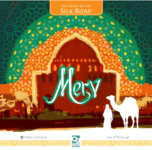

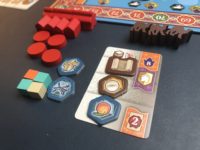
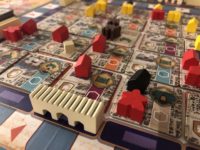
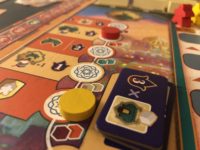


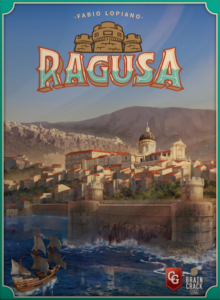


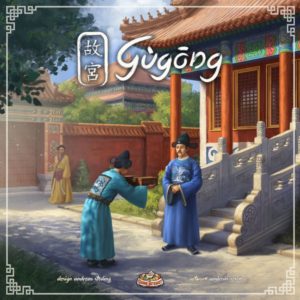
Sam says
Often complicated games have a simple heart, but I'm not convinced that's the case with Merv. Instead it has a complex heart around which are simple things. Although it's not too difficult to learn the basic mechanic of move and activate, understanding what you're doing with these activations is a bigger task and - although I'd always recommend this for heavier games, it feels especially pertinent here - if you're going to teach Merv it's definitely worth playing the game a couple of times by yourself to see where the dots join up. Even going last in a four player game you have at least 9 options to choose from, and if you're first there are 24! Understanding how influence helps with trading and contracts is important. That's also linked with protecting the city, which is linked to how many buildings you have standing after a Mongol attack, which is linked to what action you take on your turn which is impacted by turn order and so on. A real head-scratcher on my first visit, Merv has since proven incredibly more-ish, and - for the players who relish the complexities and interlocking mechanisms of these types of game - a real winner, combining those qualities with some surprisingly spicy moments of interaction in the city.